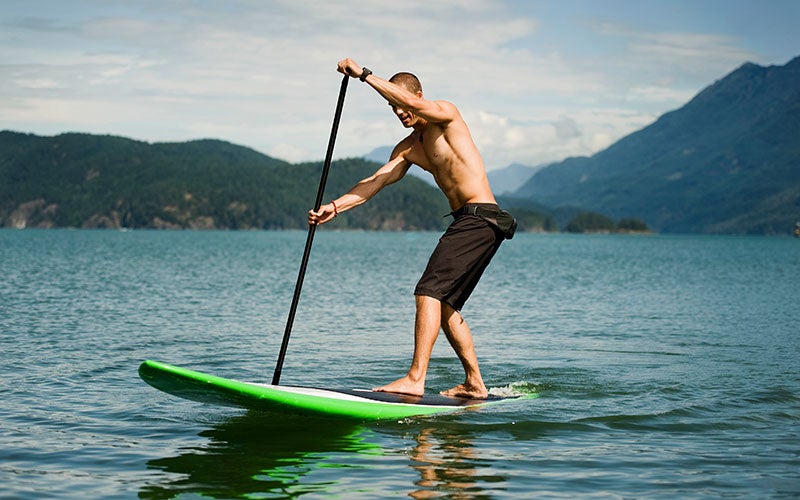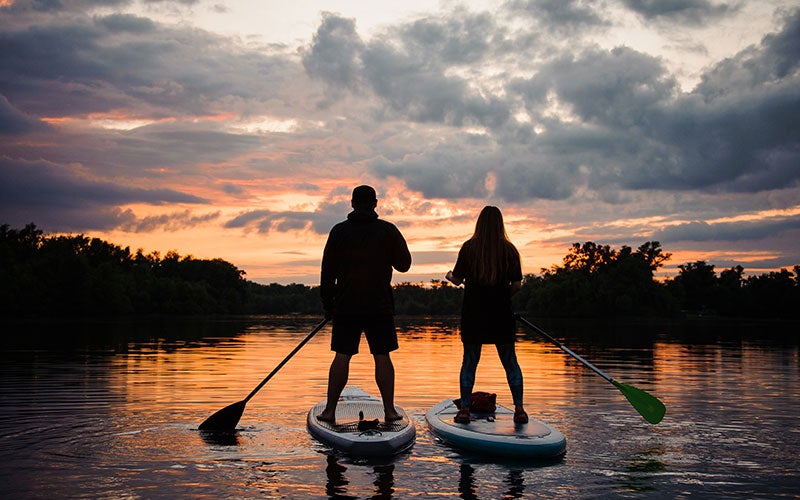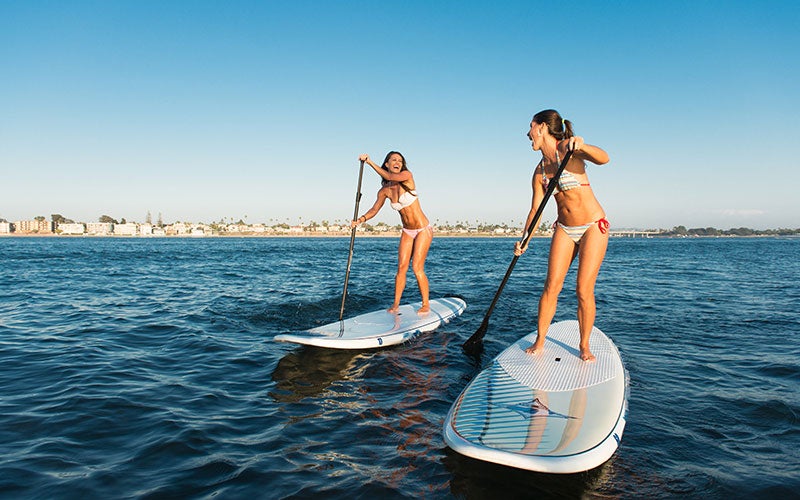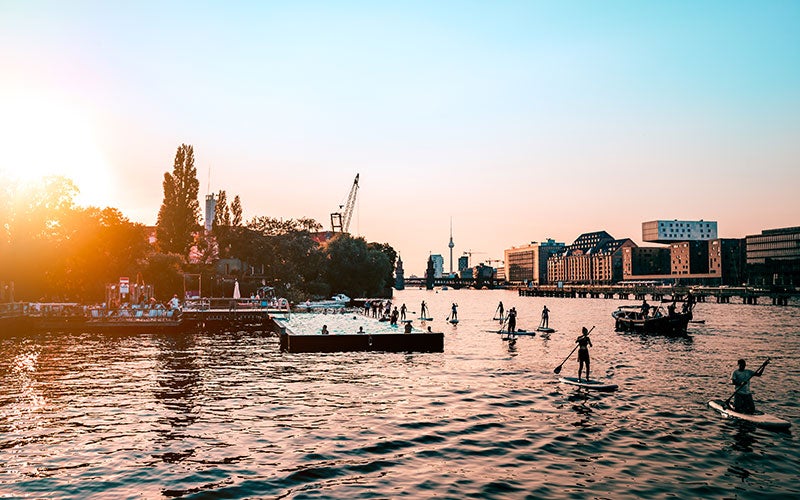Stand Up Paddle Board: Here’s how efficient the water sport really is
 ©Tegt
©Tegt
Stand Up Paddle Boarding, or SUP for short, is extremely trendy, and for good reason! Whether on a river, the lake, or the sea, wherever there’s water, when the weather’s good, there’s plenty of reason to grab a board and paddle and head out there. It’s no wonder that so many people are getting into it. SUP is not only mega fun, but also improves your stability and strengthens muscles. See what’s in store with this water sport, how effective a workout it is, and what you need to know as a beginner.
What is Stand Up Paddle Boarding?
Stand Up Paddling, or SUP for short, is a water sport that involves standing on a floating board and moving with the help of a paddle. In order to keep steady on the (wobbly) surface, you need to stay in control and keep your body engaged. Balancing and paddling trains your deep core muscles as well as your shoulders and arms. It also gently strengthens your knee and ankle joints.
SUP is particularly suitable for calm lakes and rivers where the current is not too strong, but it’s even possible in the sea. Of course, depending on the surf conditions, it can be much more demanding there.
If classic stand up paddling gets a bit too monotonous for you, you can try SUP Yoga. The floating board offers unique challenges for sun salutations.
Our tip: SUP clubs with rentals and lessons can be found just about anywhere there’s a body of water. Check one out in your neighborhood or your next vacation spot.

How does SUP work?
Let’s get down to the basics. Stand up paddling will have you standing hip-width in the middle of the board. At the start, you’ll kneel on the surface and slowly straighten up after a few paddle strokes. It’s best to bend your knees slightly to keep your balance. Your paddle should match your height and be gripped a little wider than shoulder width.
What direction will you go, and how fast? That’s up to you! You control the direction and speed of the paddle strokes. If you push the paddle left into the water, the board turns to the right and vice versa. So to go straight, you have to regularly alternate which side you’re paddling on.
The most important technique is the basic paddle stroke, which involves a dipping motion, a dragging motion, and a return motion. Dip the head of the paddle into the water ahead of you at the tip of the board, and pull it towards your body with a strong, controlled movement. Remove from the water and reset, plunging the paddle again at the front of the board.
What do you need to get on the water?
For stand up paddling, you’ll need a paddle board and a paddle. When it comes to paddleboards, you basically have two types: hard boards and inflatable boards. The latter are convenient because they can be stowed and transported in a large backpack, are high quality, and are ready to go in a few minutes with just a few pumps of air. Hard boards are usually only used in competitions.
Also, there are different SUP boards for different purposes, for example:
- Everyday: Everyday boards for recreational athletes are usually wider at the back and can be up to 4 meters long. The wider the board, the more stable, but also the slower and more sluggish it is.
- Touring: If you’re going the distance, you’ll need a versatile board. The ideal one for touring is often equipped with nets at the front and rear to carry provisions and other items for long trips.
- Racing: If you have a need for speed, a raceboard is a good choice. These are extra narrow, long, and light.
- Waves: In order to ride any waves smoothly, your board needs to be short, round, and wide. Its weight depends on your body weight.
- Yoga: if you’re looking to zen out with some yoga on the SUP, a broader board is the best choice. These are often equipped with straps for attaching therabands for workouts, for example.

When it comes to paddles, the most practical are two-piece paddles, which have a telescopic shaft and can be adjusted to the height of the rider. The ideal length here is: body height + 8 to 16 centimeters.
The larger and stiffer the blade of the paddle is, the more muscle power you need to drag it through the water. Medium-sized, flexible blades are particularly suitable for recreational use.
Additionally, a wetsuit is useful for stand up paddling, especially if you want to get out on the water in the rain or in cooler temperatures.
Our tip: Check out our list of cool outdoor sports that will keep you on your A-game this summer.
Is getting on a stand up paddle board a good workout?
Planning to cruise around a lake after work and soak up the sunset? SUP isn’t quite as chill as it seems.
To keep your balance on such a wobbly board, you have to exert every muscle. And it’s your core that’s doing a ton of the work. SUP will really fire up the abs, obliques, and transverse abdominal muscles, in particular. But the muscles in your calves, thighs, glutes, shoulders, and even neck also have to put in some serious effort to keep you on the board.
With each stroke of the paddle, you’ll also use and strengthen your upper body muscles, from biceps and triceps to shoulders, chest and back.
SUP is overall a perfect balance workout that is highly effective for the entire body. These are some of the biggest benefits at a glance:
- You sharpen your fine motor and coordination skills.
- You stabilize your joints.
- You can compensate for imbalances.
- You help prevent back pain and tension.
- You improve your posture.
- You strengthen the deep core muscles in your torso and around your spine.
- You minimize the risk of injury from sports and everyday life.
- You improve your body awareness.
- You maximize your performance.
Who should give a SUP Board a try?

Do you love to be out on the water and in the fresh air? And are you looking to add something new and exciting to your fitness rotation? Climb on board and give SUP a try. This water sport knows no age limit, and you don’t have to be a star athlete to get a lot out of it.
Having a good sense of balance is an advantage, but not a must. It’s best to let an instructor at the SUP rental explain the basic techniques to you first.
This activity is also a viable option for athletes looking to balance or supplement their routine. Poor stability can often be a weak area. Work on it and you’re sure to improve your performance in running, weight training, or yoga.
Summary
- Stand up paddling, or SUP for short, is a water sport that involves paddling while standing on a floating board.
- It can be done on lakes and rivers as well as on the sea. The more turbulent the water, the more challenging.
- You’ll need a special board and a stand up paddle. Inflatable SUP boards (I-SUP) are popular for recreational use.
- It trains your balance and, in particular, your deep core muscles, as well as fine-tunes your coordination and fine motor skills.
- SUP is a water sport that is easy on the joints and can be practiced at any age.
Sources for this article
We at foodspring use only high-quality sources, including peer-reviewed studies, to support the facts within our articles. Read our editorial policy to learn more about how we fact-check and keep our content accurate, reliable, and trustworthy.

































